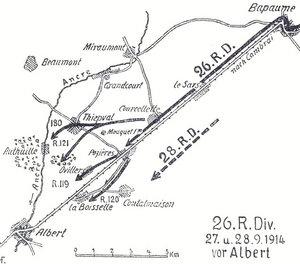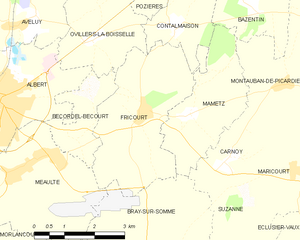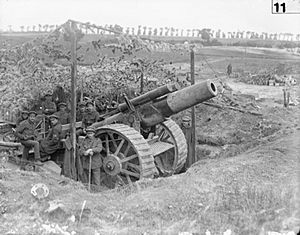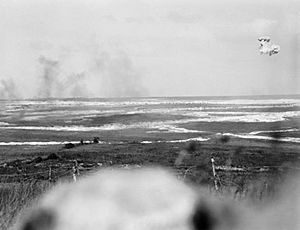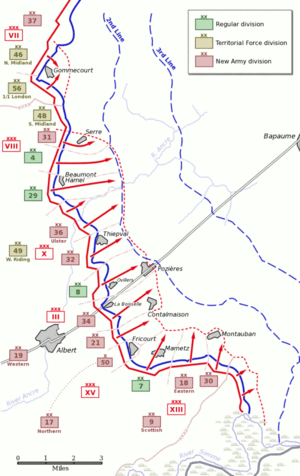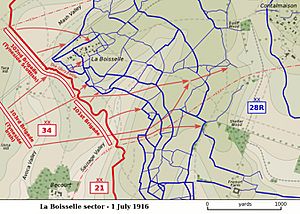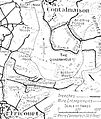Capture of Fricourt facts for kids
Quick facts for kids Capture of Fricourt |
|||||||
|---|---|---|---|---|---|---|---|
| Part of The Battle of the Somme, First World War | |||||||
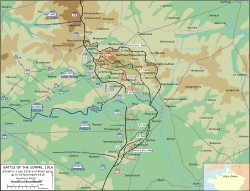 Battle of the Somme 1 July – 18 November 1916 |
|||||||
|
|||||||
| Belligerents | |||||||
| Commanders and leaders | |||||||
| Douglas Haig Henry Rawlinson Henry Horne |
Fritz von Below Hermann von Stein |
||||||
| Strength | |||||||
| 3 brigades from 3 divisions | 2 regiments, 1 battalion | ||||||
| Casualties and losses | |||||||
| 8,791 | 2,104 (1,625 prisoners) from one regiment | ||||||
| A contingent of the Bermuda Volunteer Rifle Corps was attached to a 21st Division battalion. | |||||||
Fricourt is a small village in France. It was the site of heavy fighting in July 1916. This battle was part of the larger Battle of the Somme during the First World War. The village was a strong German fort. It was located between the River Somme and the Ancre river.
The area around Fricourt was heavily fortified. German trenches were dug deep, about 1,200 yards (1,100 m). These trenches had many turns. This allowed defenders to fire from different angles.
On June 24, 1916, British artillery began firing. This was to prepare for a big attack. British soldiers attacked on July 1. They tried to break through German lines. By the end of the day, Fricourt was surrounded. German troops left the village during the night. British soldiers entered Fricourt on July 2. They captured the village and a nearby wood.
Why Fricourt Was Important
Early Fighting and Defenses
German soldiers reached Fricourt in September 1914. They were trying to move west towards Amiens. By October, the fighting had settled. Both sides dug trenches. This created a long, unmoving front line.
In December 1914, the French attacked. This caused many casualties on both sides. In 1915, the war around Fricourt went underground. Soldiers dug tunnels and set off mines. For example, 61 mines were blown near La Boisselle. This was a village just north of Fricourt.
German leaders ordered stronger defenses. They wanted to hold the front line. Barbed wire obstacles were made wider. Trenches were deepened. They also built underground shelters called dugouts. These were strong enough for 25 men. A second line of defense was built. It was far enough back to be safe from enemy artillery.
Plans for a Big Attack
In 1915, the Allied powers (France, Britain, Russia, Italy) planned a big attack. They wanted to attack at the same time. For Britain, the main fighting was in Flanders. But in February 1916, the British agreed to a joint attack. This attack would be near the Somme river. It was planned for July 1.
However, Germany attacked Verdun in February 1916. This was a huge battle. Many French soldiers were sent to Verdun. So, the British army took on the main role. They would lead the attack on the Somme. The goal was to break through German lines.
British Attack Methods
By 1916, the British had a new attack method. First, they would fire many shells. This was called a bombardment. Then, the artillery fire would slowly move forward. This was called a creeping barrage. Infantry soldiers would follow closely behind the shells. They would attack as soon as the shelling moved.
The idea was that the bombardment would destroy everything. Soldiers would then just walk in and take the ground. It was suggested that soldiers start their attack from trenches very close to the enemy. But some commanders worried this would warn the Germans. So, the decision was left to local commanders.
Getting Ready for Battle
British Preparations
The British XV Corps was in charge of the attack on Fricourt. They had three divisions of infantry. They also had many artillery guns. There was about one heavy gun for every 58 yards (53 m). And one field gun for every 25 yards (23 m).
British planes helped too. They watched German positions from the air. They also helped guide the artillery fire.
British Attack Plan
The British plan was to capture high ground first. Then, they would take Fricourt. They did not plan to attack Fricourt directly from the front. Instead, they would surround it. One group would attack Mametz village. Another group would form a defensive line. This line would face Fricourt and Fricourt Wood. Other troops would wait in their trenches. They would only advance when ordered.
The attack would start with a strong bombardment. Gas was to be released near Fricourt. Then, a smoke screen would hide the British troops. Several large mines were also set to explode. These mines were meant to destroy German defenses. They would also create craters for British soldiers to hide in.
German Defenses
The German 28th Reserve Division defended Fricourt. They had many machine-guns. These guns were placed in shell holes. They also had deep dugouts in the front line. But there were fewer dugouts further back. This meant many soldiers were crowded in the first trench.
British artillery fire was very strong. It destroyed much of the German artillery. Many German field guns were put out of action. Telephone lines were cut. Machine-guns were also destroyed.
The Battle Begins
British Attacks on July 1
The British 7th Division attacked Mametz. Some soldiers were hit by machine-gun fire from Fricourt Wood. The bombardment on Fricourt was not as effective as planned. This was because some shells did not explode properly. Despite this, some British soldiers reached the German trenches. They fought the Germans in the communication trenches.
The 21st Division attacked with several brigades. One battalion, the 10th West Yorkshire Regiment, attacked a 600-yard (550 m) front. Some companies reached the German trenches easily. But the rest of the battalion was hit by machine-gun fire. This fire came from Fricourt village. The machine-guns had survived the mine explosions. Many soldiers were killed or captured. This battalion lost 710 men. It was the worst loss for any battalion on July 1.
Other parts of the 21st Division also faced heavy fire. They tried to advance up a slope. Many soldiers were caught in no man's land. They were pinned down by machine-gun fire. Some managed to reach the German front trench. They fought off German counter-attacks.
The 64th Brigade used a secret trench. This allowed them to attack in a straight line. German machine-gunners fired from their trenches. Despite many casualties, the British took the trench. They captured 200 prisoners quickly. The advance continued. But fire from nearby woods stopped them.
Afternoon Attacks and Fricourt
By midday, British commanders thought the attack was going well. They heard reports of German retreats. So, they ordered the next phase of the attack. This was set for 2:30 p.m.
The 7th Division attacked south of Fricourt. Some companies crossed no man's land with few losses. But support companies were hit by machine-gun fire. Attempts to push forward failed.
The 50th Brigade attacked north of Willow Stream. This attack was against the strongest part of Fricourt's defenses. The bombardment failed to cut the wire. German dugouts were untouched. As soon as they advanced, soldiers were hit by fire from both sides. In three minutes, 351 soldiers were killed or wounded. Some German soldiers stood on their trench walls to fire. Only a few British soldiers reached the village. They were quickly killed or captured. The attack was stopped.
However, the 7th Division had success at Mametz. They attacked Mametz village at 3:30 p.m. About 200 German soldiers surrendered. The village was captured by 4:05 p.m. This helped to surround Fricourt.
The 21st Division gained little ground in the afternoon. But they set up a defensive line facing Fricourt. They were ordered to consolidate their positions. This meant making their captured lines stronger.
Fricourt is Captured
At 10:00 p.m., British commanders ordered the attack to continue. They wanted to take Fricourt. The area around Fricourt was quiet overnight. A German counter-attack further south was stopped.
On July 2, a British patrol reported that Fricourt was empty. They had entered the village without resistance at midnight. Another patrol captured 100 German prisoners. The village was officially occupied at noon on July 2. Only eleven German soldiers were found.
The British continued their advance. They moved through Fricourt Wood. This was difficult due to fallen trees and thick bushes. By nightfall, they had linked up with other British troops. They held the edges of Fricourt Wood and Fricourt Farm.
German Perspective
The German 28th Reserve Division was heavily hit by the British bombardment. Many artillery batteries were destroyed. Most of their field guns were put out of action. The bombardment was described as "devastating."
Many German soldiers were in the front line. Telephone lines were cut. Machine-guns were destroyed. Some German units were almost wiped out. Mine explosions caused much destruction. German counter-attacks failed. The British advance around Mametz outflanked Fricourt. This made it hard for the Germans to defend.
During the night, German commanders ordered Fricourt to be abandoned. The remaining German soldiers withdrew. This was done fairly easily because the British attack had stopped.
After the Battle
Losses
The British XV Corps had many casualties. Most were caused by machine-gun fire. The 7th Division lost 3,380 men. The 21st Division had 4,256 casualties. The 50th Brigade lost 1,155 men. The 10th Battalion West Yorkshire Regiment had 733 casualties. This was the highest loss for any battalion on July 1. The British captured 1,625 German prisoners. The German Reserve Infantry Regiment 109 had 2,104 casualties.
Later Operations
After Fricourt was captured, the British continued to advance. They moved towards the German second line of defense. This was to threaten German positions further north. New attacks were planned for July 3. These attacks aimed to capture more woods and villages.
1918
Fricourt was recaptured by German troops on March 26, 1918. This happened during the German spring offensive called Operation Michael. British troops had to retreat. The Germans thought the British were defeated. They attacked the British 51st Brigade. This brigade had only about 600 men left. The Germans suffered heavy losses.
Fricourt village was captured by the Germans that afternoon. But the British managed to stop the German advance. On March 26, the British were ordered to retreat again. The village was evacuated at 4:45 p.m. British planes saw the German advance. They worked hard to disrupt it.
Fricourt was finally recaptured on August 25, 1918. This was during the Second Battle of Bapaume.
Images for kids


